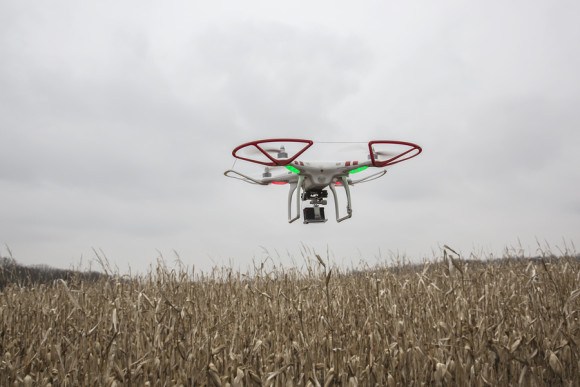The Obama administration is opening U.S. skies to more commercial drones with long-awaited regulations that the government hopes will spawn new businesses inspecting bridges, monitoring crops and taking aerial photography.
In the most comprehensive set of rules yet for the burgeoning unmanned aircraft industry, the U.S. Federal Aviation Administration on Tuesday went far beyond its original restrictive proposal issued last year. Drone operators will be able to petition the agency to fly beyond the horizon, at night and over people if they can show such flights are safe.
“We are in the early days of an aviation revolution that will change the way we do business, keep people safe, and gather information about our world,” President Barack Obama said in an interview with Bloomberg News. “This is just a first step, but this is the kind of innovative thinking that helps make change work for us—not only to grow the economy, but to improve the lives of the American people.”
Low Flights
The rules could be a boost for drone manufacturers such as SZ DJI Technology Co. of China, the world’s largest. U.S. companies that have been working with the FAA on expanding drone operations, such as PrecisionHawk in Raleigh, N.C., and AirMap Inc. of Santa Monica, Calif., also stand to benefit.
The basic rules permit only low-level flights that remain within sight of an operator or nearby assistant and don’t go over people. The new regulations, which will become effective two months from publication in the Federal Register, took years to craft and are seen as a critical step toward realizing the potential of drones to perform such tasks as monitoring crops, inspecting power lines and pipelines as well as assisting government agencies in disasters.
The basic rules permit only low-level flights that remain within sight of an operator or nearby assistant and don’t go over people. Drone operators-for-hire will have to pass a written test and be vetted by the Transportation Security Administration—but no longer need to be airplane pilots as current law requires. Drones under the regulation must weigh less than 55 pounds (25 kilograms) and keep speeds below 100 miles (161 kilometers) per hour.
Allowing a device to be within eyesight of an assistant—a change from the proposed rules industry advocates won in the final version—means an operator can guide a drone by its video signal.
Drone package deliveries by companies such as Amazon.com Inc. and Alphabet Inc.’s Google Project Wing aren’t allowed under the regulations until the FAA writes separate rules governing their use. Similarly, the limitations in the regulations won’t initially permit longer flights for agricultural flyovers, pipeline and utility inspections and news media photography over crowds.
However, the agency heeded industry comments to its earlier proposal and added flexibility so that many such activities would be permitted under a waiver program, FAA Administrator Michael Huerta said in a telephone briefing.
“Our focus is to make this as streamlined as possible,” Huerta said. The agency will open an online portal through which applicants can learn how to file for waivers, he said.
Solving the more complex problems inherent in drone deliveries—which envision autonomous vehicles buzzing over highly populated areas—is a “very active research program,” Huerta said. He declined to set a timetable on when such flights would be permitted.
While the rules don’t apply directly to hobbyists, who don’t need a license to fly if they’ve registered their drones with the FAA, it lays out the government’s authority to enforce aviation regulations on all unmanned aircraft.
Symbolic Victory
Drone-advocacy groups called the regulations a symbolic victory that paves the way for those future uses. The Association for Unmanned Vehicle Systems International trade group forecasts drones will produce $82 billion in economic value and create more than 100,000 new jobs in the first 10 years after widespread flights are approved.
“This is a watershed moment in how advanced technology can improve lives,” Brendan Schulman, drone maker DJI’s vice president of policy and legal affairs, said in an e-mailed statement. “After years of work, DJI and other advocates for reasonable regulation are pleased that the FAA now has a basic set of rules for integrating commercial drone operations into the national airspace.”
The FAA’s decision to drop a requirement for a pilot’s license “is a significant win” for the industry that opens it to many more operators,” Diana Cooper, PrecisionHawk’s senior director of policy, said in a web posting.
“I regard it as a significant milestone,” said AUVSI President Brian Wynne, who had been pushing FAA to issue the regulations for years. “We’ll accelerate the process of understanding what the risks are that will allow us to move on to more complex operations.”
For some companies, the rules didn’t move fast enough. “We still have a long way to go, specifically when it comes to long-distance, or beyond visual line-of-sight, drones,” Tero Heinonen, chief executive officer of Sharper Shape Ltd., a Finnish-based company that has begun power-line inspections in Europe, said in a statement. The company expects to apply to the FAA for a waiver within months, Heinonen said.
Ahead of EU
The release of the rules puts the U.S. ahead of Europe in setting standards for the drone industry. The European Union has yet to adopt comprehensive rules for civilian drones, according to the European Aviation Safety Agency website. Individual nations have imposed restrictions, but they differ across borders. EASA is trying to develop rules by 2017.
The FAA has already convened groups to study how to eventually allow such flights without waivers. Test programs are examining how to: approve long-range drone flights in which an operator steers with video images; make unmanned craft safe to fly over people; and expand agricultural uses.
The Obama administration also announced new federal initiatives with NASA, the FAA and other government agencies to study how to broaden drone uses for tasks such as disaster response and environmental monitoring. NASA is already developing an air-traffic control system for low-altitude drones.
Privacy Concerns
Privacy concerns will be addressed by a new government campaign to educate operators and businesses. The National Telecommunications and Information Administration last month issued non-binding privacy policy suggestions. Commercial drone operators will be tested on privacy issues as part of their license, according to the Obama administration.
The FAA has permitted commercial drone operations—those conducted for hire, as opposed to recreational flights by hobbyists who don’t need a license—since September 2014 under a case-by-case exemption process ordered by Congress. Drone operators under this program had to have a traditional pilot’s license. As of June 2, the agency had granted 6,004 such permits to fly drones commercially.
The new regulation allows a far easier approval process and is expected to swell the ranks of commercial operators. The agency is dropping the requirement for a pilots’ license, relying instead on a simpler knowledge test. FAA-approved drone operators will have more leeway to fly different drone models and multiple missions.
‘Major Step’
The regulations also will promote safety at a time when hundreds of thousands of hobbyists are flying with limited FAA oversight, Wynne said. There were more than 1,200 reports of drone safety incidents last year, including flying too close to airliners, according to FAA.
The new rules codify what until now have been set out as FAA policy statements and interpretations. All drones are aircraft and subject to FAA enforcement actions if operators are reckless or fly in prohibited zones, according to the agency.
“We need an attitude of professionalism where people are working to improve the safety record all the time,” Wynne said. People who obtain FAA drone-pilot certificates will now have an economic incentive to help police the system, he said.
Operators will be restricted to flying below 400 feet, more than five miles from an airport without obtaining FAA permission and must keep the device within sight—limiting flights to roughly a quarter mile.
AIA Comment Below Added by Carrier Management
Separately, the American Insurance Association (AIA), issued the following statement from Tom Santos, vice president of federal affairs, in response to the announcement of FAA’s adoption of the new rule. “AIA was encouraged by the FAA’s rule announcement pertaining to the commercial use of unmanned aerial systems. While we are still reviewing the rule, it appears to offer much needed flexibility and pathways forward for insurers to utilize this important technology.
“Insurers believe that, as an example, this technology can be valuable in serving policyholders following a natural catastrophe by aiding in the adjustment of claims, while also not putting lives at risk.”
AIA noted that the new rule pertaining to use of unmanned aircraft systems is contained in Part 107 of the FAA’s operation rules, and includes the continued use of drones for anyone who has a 333 waiver allowing for commercial use of UAS.





















 Carrier Management’s 2025 Top Features (Reader’s Picks Unlocked)
Carrier Management’s 2025 Top Features (Reader’s Picks Unlocked)  Market Softening Accelerates During 1/1/2026 Re Renewals
Market Softening Accelerates During 1/1/2026 Re Renewals  Final Sentencing in Large Scale Crop Fraud Case That Cost Insurers Nearly $35M
Final Sentencing in Large Scale Crop Fraud Case That Cost Insurers Nearly $35M  Northern California Flooding This Weekend Caused by Heavy Rain, High Tides
Northern California Flooding This Weekend Caused by Heavy Rain, High Tides 



